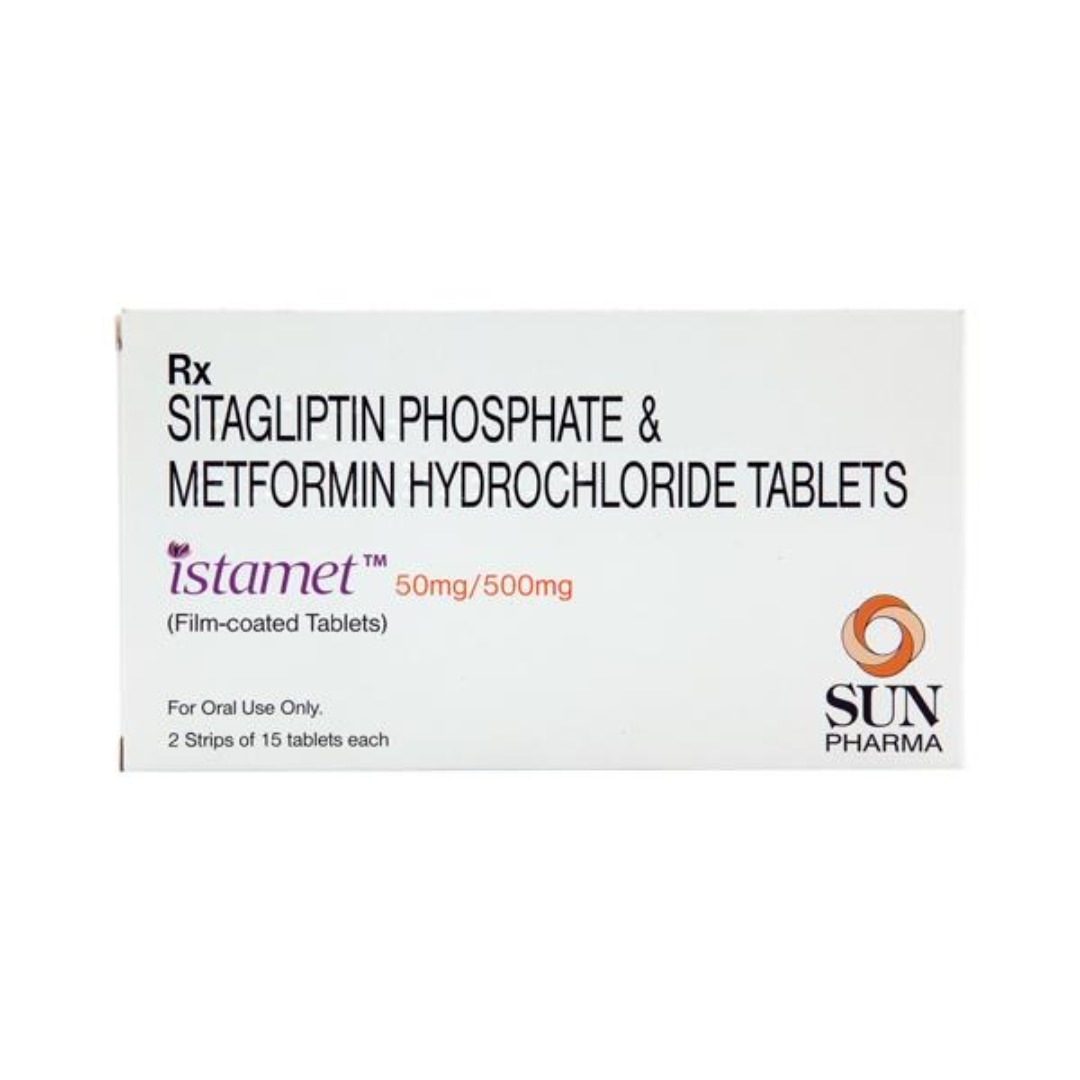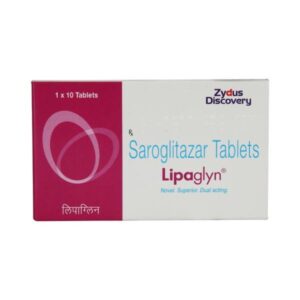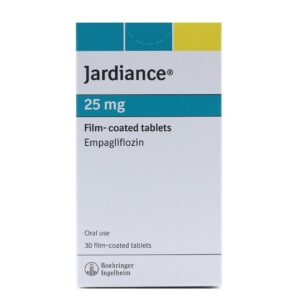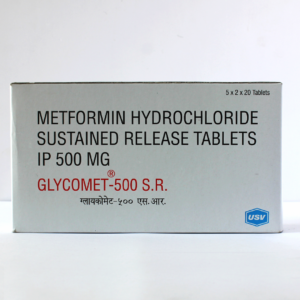Istamet 50 mg/500 mg
Istamet 50 mg/500 mg is a combination medicine that contains Sitagliptin (a DPP4 inhibitor) and Metformin (a Biguanide). It is an anti-diabetic medication. Type 2 diabetes is a disorder in which the body either stops producing enough insulin (the hormone that aids in lowering blood sugar levels) or develops resistance to insulin’s action. As a result, insulin is created in high quantities yet is incapable of acting on the body’s organs.
Sitagliptin is a member of the class of dipeptidyl peptidase-4 (DPP-4) inhibitors. It works by boosting the levels of certain naturally occurring chemicals that help to reduce blood sugar when it is elevated. Yet another medication Metformin is a member of the class of drugs known as biguanides. It works by decreasing glucose synthesis in the liver, delaying glucose absorption from the intestines, and increasing the body’s insulin sensitivity. When taken in combination, it prevents blood glucose levels from rising to dangerously high levels following meals.
To avoid an upset stomach, use Istamet 50 mg/500 mg with food. Istamet 50 mg/500 mg should be taken consistently at the same time of day. For the best guidance, your doctor will determine the appropriate dose, which may alter periodically based on your condition. Hypoglycemia (low blood glucose levels) is the most often reported side effect of Istamet 50 mg/500 mg. Symptoms include dizziness, sweating, palpitations, hunger pangs, and dry mouth and skin. Therefore, to avoid hypoglycemia, you should avoid skipping meals and carry some form of sugar with you. Additionally, taste changes, nausea, diarrhea, stomach pain, headaches, and upper respiratory problems may occur.
Istamet 50 mg/500 mg should not be discontinued without visiting your doctor, as your blood sugar level will continue to fluctuate. If you suddenly stop using Istamet 50 mg/500 mg, your blood sugar levels may rise, increasing your risk of vision loss (retinopathy), kidney damage (nephropathy), and nerve damage (neuropathy). Istamet 50 mg/500 mg should be avoided if you have type 1 diabetes, significant kidney disease, or liver illness. Kindly notify your physician if you have any type of cardiac disease, are pregnant or planning to become pregnant, or are breastfeeding.
Istamet 50 mg/500 mg Diabetes Mellitus Type 2

Medicinal Advantages
Istamet 50 mg/500 mg stimulates the pancreas to produce more insulin, improves insulin utilization, and decreases the amount of sugar produced by the liver. It aids in regulating the rise in blood sugar levels following a meal. Additionally, chronic use does not result in weight increase. Istamet 50 mg/500 mg is critical for blood sugar control and the prevention of major diabetes consequences such as vision loss (retinopathy), kidney damage (nephropathy), nerve damage (neuropathy), diabetic foot ulcers, and delayed wound healing.
Use Instructions
Istamet 50 mg/500 mg should not be used unless a doctor has recommended it. Always take Istamet 50 mg/500 mg exactly as prescribed by your physician. Your doctor will determine the frequency with which you should take your medications based on your medical condition. With a full glass of water, swallow the tablet. Tablets can be broken in half if necessary to provide a lesser dose.
Storage
Store in a cool, dry location away from direct sunlight.
Istamet 50 mg/500 mg Adverse Reactions
Each medication has some adverse effects. When combined with other anti-diabetic agents such as sulfonylurea or insulin, you may experience low blood sugar, runny nose, sore throat, upper lung infection, diarrhoea, nausea and vomiting, gas, stomach upset, indigestion, general weakness, and headache during the first days of treatment with Istamet 50 mg/500 mg. However, they would be transient and might be alleviated after a period of time. However, if you continue to experience difficulty, consult a physician. Lactic acidosis (an abnormally high quantity of lactic acid in the blood) is a rare but dangerous adverse effect that can progress to a life-threatening condition.
Adverse Drug Reactions
Metformin and sitagliptin are contraindicated in type 1 diabetes and diabetic ketoacidosis. While using Metformin and Sitagliptin, certain diabetic individuals may develop a rare but deadly complication called lactic acidosis. In this disease, there is an excess of lactic acid in the blood, which can impair the function of your liver and kidneys, which are responsible for removing excess lactic acid from the blood. Inform your doctor before starting Metformin and Sitagliptin if you have ever had pancreatitis (pancreatic inflammation), kidney problems, or a low vitamin B12 level. When combined with insulin, metformin and sitagliptin may cause dangerously low blood sugar levels, known as hypoglycemia. Your doctor may change the dose in this scenario by decreasing the dose of insulin, Metformin, or Sitagliptin. Because prolonged use of Metformin and Sitagliptin may result in a decrease in thyroid-stimulating hormone (TSH), an annual TSH testing is suggested. In rare instances, you may also get a severe skin response called bullous pemphigoid, which requires prompt medical attention. Inform your doctor if you are scheduled for a diagnostic test that will involve the injection of dye or an X-ray contrast agent. Metformin and Sitagliptin should be discontinued for a brief period before to having an X-ray procedure.
Interactions Between Drugs
Interactions Between Drugs: Istamet interact with antidepressants (bupropion), glaucoma medications, antibiotics (cephalexin, ciprofloxacin), anti-acidity medications (cimetidine), anti-HIV medications (dolutegravir), ethanol, saliva-thinning medications (glycopyrrolate), iodinated X-ray contrast agents, anti-epileptic medications (topiramate, lamotrigine) (ranolazine). Other medications, such as sex hormones (androgens), antioxidants (alpha-lipoic acid), pain relievers (aspirin), anti-TB drugs (prothionamide), growth hormones (pegvisomant), and other antidiabetic medications, may also contribute to an increased risk of low blood sugar.
Drug-Food Interaction: Excessive consumption of alcoholic beverages may raise the risk of developing a potentially fatal illness called Lactic Acidosis. As a result, avoid alcoholic beverages while taking Istamet .
Drug-Illness Interaction: Individuals who have a history of cardiac disease (such as congestive heart failure or myocardial infarction), Vitamin B12 deficiency, or alcoholism should avoid Metformin and Sitagliptin.
Safety Recommendations
ALCOHOL
It is prudent to abstain from drinking when on medicine.
PREGNANCY
Please with your physician before to utilizing Metformin or Sitagliptin.
FEEDING OF THE BREAST
Please with your physician before to utilizing Metformin or Sitagliptin.
DRIVING
Drive only if you are physically stable and mentally focused. If you feel drowsiness as a side effect of these medications, you should refrain from driving or operating machinery or automobiles.
LIVER
If you have a history of or indications of liver disease, please see your doctor prior to using this medication.
KIDNEY
If you have a history of or indications of kidney illness, please see your doctor prior to using the medication.
No Habit Formation
Advice on Diet and Lifestyle
Half of your plate should be starchy vegetables, a quarter protein, and a quarter whole grain.
Consume food at regular intervals. Do not wait an extended period of time between meals or snacks.
Regularly monitor your blood sugar level, especially if there are significant swings.
Each week, commit to at least 150 minutes of moderate-intensity physical activity or one hour and 15 minutes of vigorous exercise.
Weight loss should be gradual in order to maintain a healthy body mass index (18.5 to 24.9).
Substitute whole grain foods for refined carbohydrate foods and boost your intake of fruits, vegetables, and other fiber-rich foods.
Reduce saturated fat (or hidden fat) consumption in foods such as chips, crisps, pastries, biscuits, and samosas. For daily cooking, choose oils high in omega 3 fatty acids. Use palm oil, mustard oil, groundnut oil, rice bran oil, or safflower oil for frying.
Avoid stress, as it may cause your blood sugar level to rise. You can control stress-related blood sugar variations by implementing stress management practices such as mindfulness.
Make a point of purchasing low-fat dairy products (low-fat yoghurt, fat-free milk, and cheese, etc.).
Maintain a normal blood pressure (140/90) as much as feasible. Due to the fact that it lowers the risk of cardiovascular disease in diabetic people.
Additionally, this item is non-returnable.
Concern for Patients
Type 2 diabetes is a condition in which the body is unable to produce enough insulin or the insulin it does produce does not act correctly or is not properly utilized by the body. This can result in elevated blood sugar levels (hyperglycaemia). Increased thirst, frequent urine at night, poor wound healing, increased hunger, weariness, and blurred eyesight are all symptoms of type 2 diabetes. In certain circumstances, weight increase may occur, whereas in rare instances, weight reduction may occur. Type 2 diabetes complications include neuropathy (nerve damage), nephropathy (kidney damage), retinopathy (damaged retina of the eyes or blindness), amputation of limbs, sexual dysfunction, and an increased risk of heart attack or stroke.
FAQs
Kind 2 diabetes is a frequent type of diabetes in which the body’s natural blood sugar-lowering hormone, insulin, does not operate effectively. As a result, blood glucose levels rise, and symptoms such as frequent urination, increased thirst, and increased appetite begin to manifest. Diabetes, if left untreated or not adequately treated, can result in long-term complications such as nerve damage, kidney damage, eye damage, and foot difficulties, as well as a significantly increased risk of developing heart disease.
If you experience symptoms such as increased hunger, increased thirst, frequent urination (typically at night), unexplained weight loss, exhaustion, blurred vision, slow wound/sore healing, or repeated infections, consult a physician since this could be a sign of type 2 diabetes.
Lactic acidosis is an uncommon but potentially fatal illness that occurs when too much lactic acid accumulates in the bloodstream. When cells are depleted of oxygen, prolonged use of Metformin plus Sitagliptin may result in lactic acidosis. Lactic acidosis is characterized by a burning sensation in the muscles, muscle discomfort, rapid breathing, nausea, and stomach pain. Contact your physician immediately if this issue occurs.
If you feel as though your blood sugar is dropping and you are becoming weak, immediately consume sugar candies or sugary beverages. It will assist in balancing your body’s blood sugar levels. As a result, it is prudent to have sugar candies with you.
Avoid excessive alcohol consumption while taking Metformin and Sitagliptin, as this may raise your chance of developing a potentially fatal condition called lactic acidosis (too much of lactic acid in the body).
Metformin and Sitagliptin are used only to treat type 2 diabetes, also referred to as ‘non-insulin-dependent diabetes’.








Leave a Reply
You must be logged in to post a comment.